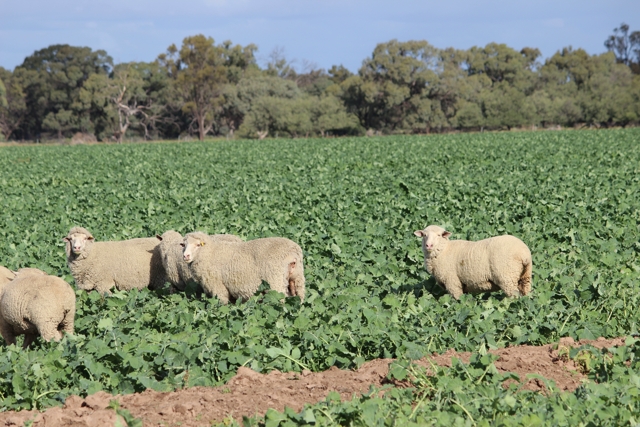Grazing winter crops - issues to consider
 PRODUCTION ADVICE - MARCH 2021 - AGRONOMY / ANIMAL HEALTH
PRODUCTION ADVICE - MARCH 2021 - AGRONOMY / ANIMAL HEALTH
By John Fowler (Extension Agronomist) & Adrian Smith (Senior Land Services Officer)
P: (03) 5881 9933 | M: 0427 079 138 | E: john.fowler@lls.nsw.gov.au - (John)
P: (03) 5881 9932 | M: 0447 778 515 | E: adrian.smith@lls.nsw.gov.au - (Adrian)
Heading into autumn, livestock producers will be thinking about their feed production options.

Before considering planting some grazing winter crops this autumn, producers need to be aware of both the animal health and agronomic issues associated with doing so. The following is a brief checklist of issues to consider.
Agronomic issues
Commencement: Grazing can start once the plants are well-anchored. This is easily checked by pulling on the leaves to see whether the plants pull out of the soil or break off, leaving the crowns well-anchored. Cereals may be adequately anchored by the three-leaf stage, but it is desirable to delay grazing until the 5-6 leaf stage, if possible, to provide more feed on offer. Brassicas (e.g. canola) are not likely to be well anchored until about the six-leaf stage.
Chemical withholding periods: Before starting grazing, ensure that no pesticides, including seed dressings, are still within chemical withholding periods. Some fungicide dressings (e.g. Uniform®) have up to six weeks grazing withholding, and seed treated with triadimefon can’t be grazed at all. Most insecticide seed treatments have eight or nine weeks grazing withholding periods.
Herbicide grazing withholding periods can also be quite extensive. Boxer® Gold, for example, has a 10-week withholding period, Sakura® has six weeks withholding.
Finishing grazing: If you are looking to maximise grain recovery, then stock need to be removed before the plant enters the reproductive growth phase.
For cereals, this will be once tillering finishes and the plant is ready to start stem elongation – i.e. growth stage DC30, prior to the formation of the first node. At this stage, the developing head moves from being at or below ground level to above ground level. This renders it vulnerable to being damaged or removed by grazing.
For brassicas, remove stock at the mid-dormant stage, about July.
Livestock health issues
Vaccinate stock prior to grazing: Veterinary advice is to give a booster vaccine, such as ‘5-in-1’, a couple of weeks before turning them onto winter crops.
Eve Hall, LLS District Veterinarian in Holbrook, says cereal crops are high in water-soluble carbohydrates, and this puts stock at an increased risk of an overgrowth of clostridial bacteria in the gut. A booster vaccine is a cheap, simple and effective measure to reduce pulpy kidney losses during the change in diet.
Just a word of advice – the pulpy kidney component of these multi-strain vaccines is likely to provide maximum protection for around three months. If you are turning livestock onto high quality forage, it is essential that the booster vaccination is current.
Provide a mineral supplement: It has become standard practice to give stock access to a ‘loose lick’ when they are grazing winter cereals, particularly wheat. Growth rates can be very disappointing if stock do not have access to extra calcium and magnesium while grazing cereals (particularly Wedgetail wheat). There is very good evidence that highlights improved livestock performance when providing this type of supplementation.
Mixing coarse salt, agricultural lime and causmag at a ratio of 2:2:1 produces a relatively inexpensive lick. Stock need to have unrestricted access to the lick to provide them with adequate mineral supplementation. Initially, you may need to increase the salt and decrease the causmag to encourage them onto the lick. Then, over the course of a few weeks, reduce the salt and increase the causmag until the 2:2:1 ratio is achieved.
The causmag component of the loose lick is very bitter (palatability can be a problem), and can set ‘rock hard’ when wet. There are some alternate licks that overcome some of these problems.
Avoid nitrate poisoning – don’t graze within three weeks of topdressing: When crops take up nitrogen after a topdressing, their nitrate levels can increase to toxic levels. A simple guide is to avoid grazing for three weeks after topdressing nitrogen fertiliser.
Feed animals hay prior to introducing them to winter crops: Ruminants can tolerate quite high levels of nitrate in their diet, converting it through to ammonia. However, if they have a sudden increase in nitrate intake, they are unable to convert it quickly enough to avoid nitrate poisoning. The main risk period is when stock first enter winter crop paddocks. If they are hungry, they will eat large amounts of the lush feed, potentially taking in high nitrate levels.
Feeding them hay, ensuring they are full, and moving them onto winter crops in the afternoon will reduce this risk.
Provide hay supplement while grazing brassica crops: Brassicas, such as canola, are highly nutritious but are low in fibre. Livestock will compensate for this by consuming some hay, if it is on offer, while grazing the canola. A grassy or cereal hay is quite adequate for this purpose. The stock will gain most of their nutrition from the brassica, but will self-compensate for the low fibre by eating some hay. Without this source of fibre, growth rates will be lower.
Monitor your livestock: There is a range of potential livestock disorders which can result from grazing winter crops. Cattle grazing canola can be particularly prone to digestive and reproductive disorders,digestive irritation, anaemia, respiratory distress, PEM (polioencephalomalazia) and oxalate poisoning. These problems are exacerbated when plants are under stress (drought, frost etc), or when actively growing.
Careful attention to your livestock management, with a steady transition onto new feeds (to allow time for the rumen bugs to adjust to a new diet), is important. Keep a close eye on your grazing regime and your livestock in general.
Set stocking or rotationally graze? The research suggests that set stocking is likely to maximise animal productivity from these types of systems.
The other important consideration is length of grazing. There is little benefit in allowing your livestock to graze a certain crop for a short period of time and then remove them. The rumen bugs take time to adjust to a new diet. Grazing a paddock of canola for two weeks, and then moving the animals on to a completely different feed will likely result in disappointing livestock performance. At least a month is required to see measurable gains, so have enough paddocks to ensure adequate grazing time on similar crops.
In summary, any winter crop can be grazed successfully, provided your management of both the crop and your livestock is up to scratch.
Keeping a careful eye on your livestock, particularly during the induction period. Ensuring your animal health treatments are up-to-date and the stock have ad-lib access to fibre and mineral supplements. Monitor plant nutrition and grazing withholding periods. By taking these steps, you will give your livestock every opportunity to maximise the benefits from grazing high-quality winter crops.